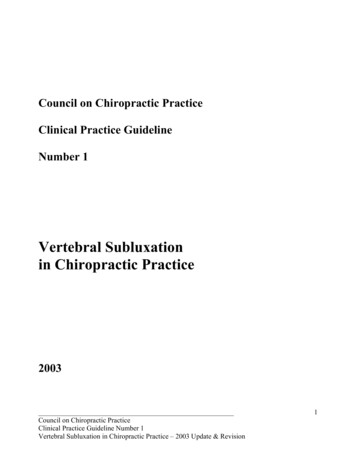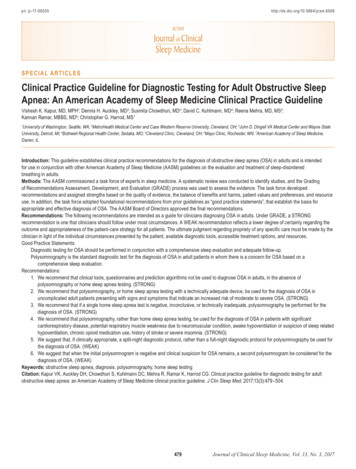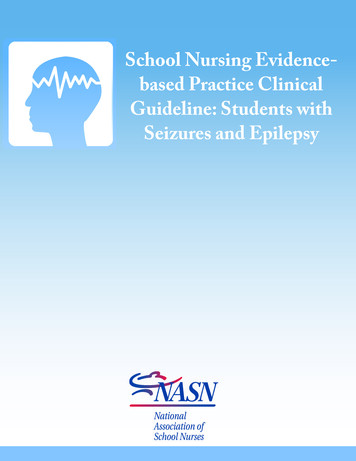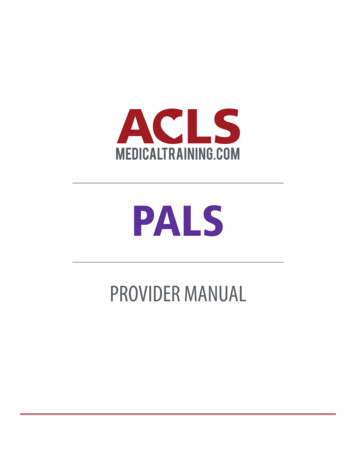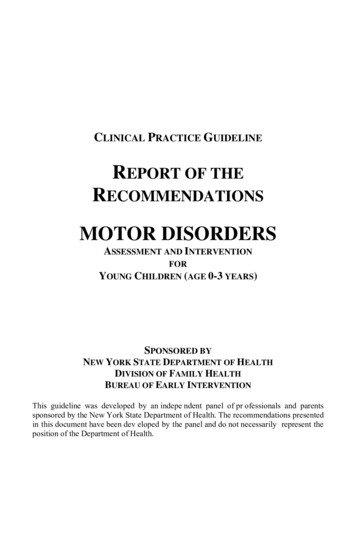
Transcription
CLINICAL PRACTICE GUIDELINEREPORT OF THERECOMMENDATIONSMOTOR DISORDERSASSESSMENT AND INTERVENTIONFORYOUNG CHILDREN (AGE 0-3 YEARS)SPONSORED BYNEW YORK STATE DEPARTMENT OF HEALTHDIVISION OF FAMILY HEALTHBUREAU OF EARLY INTERVENTIONThis guideline was developed by an indepe ndent panel of pr ofessionals and parentssponsored by the New York State Department of Health. The recommendations presentedin this document have been dev eloped by the panel and do not necessarily represent theposition of the Department of Health.
GUIDELINE ORDERING INFORMATIONOrdering information for New York State residents: The guideline publications areavailable free of charge to New York State residents.To order, contact:PublicationsNew York State Department of Health, P.O. Box 2000, Albany, New York 12220Fax: (518) 486-2361Ordering information for non-New York State residents: A small fee will be chargedto cover printing and administrative costs for orders placed by nonresidents of New YorkState and for multiple copies requested by other than those above.To order, contact:Health Education ServicesP.O. Box 7126, Albany, New York 12224www.hes.orgMasterCard and Visa accepted via telephone: (518) 439-7286.Publication Titles1.Clinical Practice Guideline: The Guideline Technical Report.Motor Disorders, Assessment and Intervention for Young Children(Age 0-3 Years). 8½" x 11", 422 pages. Publication No. 4963. 20061a. Evidence Tables – Assessment and Intervention. 8½" x 11", 70 pages. PublicationNo. 4975. 20062.Clinical Practice Guideline: Report of the Recommendations.Motor Disorders, Assessment and Intervention for Young Children(Age 0-3 Years). 5½" x 8½", 322 pages. Publication No. 4962. 20063.Clinical Practice Guideline: Quick Reference Guide.Motor Disorders, Assessment and Intervention for Young Children(Age 0-3 Years). 5½" x 8½", 170 pages. Publication No. 4961. 20064.Clinical Practice Guidelines on Compact Disc: Includes – Guideline TechnicalReport, Report of the Recommendations, and Quick Reference Guide, Publication No.4964. 2006For permission to reprint or use any of the contents of this guideline, or for moreinformation about the NYS Early Intervention Program, contact:NYS Department of HealthBureau of Early InterventionCorning Tower Building, Room 287, Empire State Plaza, Albany, New York 12237-0660Tel (518) community/infants children/early intervention/index.htm
The New York State Depar tment of Health gratefully acknowledgesthe contributions of individu als who have participated as guidelinepanel members and peer rev iewers for the development of thisclinical practice guideline. Their insights and expertise have beenessential to the development and credibility of the guidelinerecommendations.The New York State De partment of Health Bureauof EarlyIntervention especially appreciates the advice and assistance of theNew York State EarlyIntervention Coordinating Council andClinical Practice Guidelines Project Steering Committee on allaspects of this important effort to improve the quality of earlyintervention services for young children who have a motor d isorderand their families.The contents of the guideline were developed under a grant from the U.S.Department of Education. However, the contents do not necessarily representthe policy of the Department of Education, and endorsement by the federalgovernment should not be assumed.
The New York State Early Intervention Program does not discriminate on thebasis of handicap in admission, or access to, or treatment or employment in itsprogram and activities.If you feel you have been discriminated against in admission, or access to, ortreatment or employment in the New York State Early Intervention Program, youmay, in addition to all other rights and remedies, contact: Director, Bureau ofEarly Intervention, New York State Department of Health, Room 287, CorningTower Building, Empire State Plaza, Albany, NY 12237-0660.
Table of ContentsMotor DisordersAssessment and Intervention for Young Children (Age 0-3 Years)Preface .xiiiWhy the Bureau of Early Intervention Is Developing Guidelines . xivChapter I: Introduction .1Purpose of This Clinical Practice Guideline. 2Reasons for Developing This Guideline . 2Definition of Motor Disorders. 3Scope of the Guideline. 3Definition of Other Important Terms . 4The Importance of Using Scientific Evidence to Help Shape Practice. 5Overview of the Methods Used to Evaluate the Evidence . 6Strength of Evidence Ratings. 7Using Scientific Evidence as the Basis for Clinical Decision Making . 8Peer Review, Guideline Versions, and Periodic Revision . 10Chapter II: Background Information.13What Is Motor Development?. 14What Is Typical Motor Development? . 15What Are Some of the Important Components of Motor Development? . 16How Do Prematurity and Other Health Conditions Impact Motor Development?. 18What Is a Motor Disorder? . 20How Common Are Motor Disorders and Cerebral Palsy? . 22What Do We Know About the Causes of Motor Disorders? . 23What Is the Impact on the Child and Family of Having a Motor Disorder?. 24Do Some Children Outgrow Motor Disorders? . 25Chapter III: Assessment.27General Approach for the Identification and Assessment of Young Children WhoHave a Motor Disorder. 29Identifying Young Children Who Have a Motor Disorder . 34Assessing Young Children Who Have a Motor Disorder . 56NYSDOH Report of the Recommendations: Motor Disorders v
TABLE OF CONTENTSOral-Motor Assessment for Feeding and Swallowing. 66Assessing Other Developmental Domains for Young Children Who Have a Motor Disorder. 78Assessing the General Health Status of Young Children Who Have a Motor Disorder . 87Considerations for Working With the Family . 91Chapter IV: Intervention.103General Approach to Interventions for Young Children Who Have a Motor Disorder . 104Motor Therapy Approaches and Techniques . 131Assistive Technology and Adaptive Devices . 145Oral-Motor Feeding and Swallowing Interventions . 155Approaches for Spasticity Management. 161Orthopedic Management and Surgery . 169Interventions for Associated Health Conditions. 177Other Intervention Approaches for Young Children Who Have a Motor Disorder . 178Appendix A:Methodology Tables .185Appendix B:Summary of Evidence .195Appendix C:Developmental Assessment Tests .211Appendix D:Early Intervention Program Information.241Appendix E:Classification of Cerebral Palsy.257Appendix F:Additional Resources.263Appendix G:Peer Reviewers .267Bibliography.273Subject Index.297vi NYSDOH Report of the Recommendations: Motor Disorders
TABLE OF CONTENTSList of TablesTable 1:Developmental Motor Milestones . 15Table 2:Risk Factors for Motor Disorders. 41Table 3:Clinical Clues of a Possible Motor Disorder. 42Table 4:Developmental Motor Milestones . 49Table 5:Milestones Relevant to Normal Feeding. 69Table 6:Clinical Clues of a Possible Feeding Problem . 70Table 7:Questions to be Considered in the Feeding History. 71Table 8:Components of an Initial Oral-Motor Assessment. 73Table 9:Instrumental Assessments for Abnormal Swallowing . 77Table 10: Common Associated Conditions in Children With Cerebral Palsy. 89Table 11: Questions to Ask When Selecting Interventions .120Table 12: Important Components of Developmental Supportive Care .126Table 13: Basic Exercise Definitions.133NYSDOH Report of the Recommendations: Motor Disorders vii
Motor DisordersClinical Practice Guideline Development PanelBrian Rogers, MDGuideline Panel ChairmanDevelopmental PediatricianRobert Warner Rehabilitation CenterBuffalo, New YorkHarvey Bennett, MDPediatric NeurologistS.S. Lamm Institute of Child Neurologyand Developmental MedicineBrooklyn, New YorkSusan Breznak-Honeychurch, BA, PTNew Directions Child andFamily CenterFredonia, New YorkJayne Calabro, PhD, PTSt. Francis HospitalWest Park, New YorkJudy Connor Tarver, MEdOnondaga Community CollegeAuburn, New YorkDiane deRoos, MS, CCC-SLPE. John Gavras CenterAuburn, New YorkDelia Gorga, OTR, PhD, FAOTADepartment of Rehabilitation MedicineNew York-Presbyterian HospitalNew York, New YorkGail Landsman, PhDParent RepresentativeAnthropology DepartmentSUNY at AlbanyAlbany, New YorkLinda Mancz, MA, CCC-SLP, MBAUnited Cerebral Palsy Association ofNassau County, Inc.Roosevelt, New YorkZenobia MannParent RepresentativeBrooklyn, New YorkBarbara Mykytyn, MSParent RepresentativeWest Oneonta, New YorkJanine Pollack, PhDPsychologistS.S. Lamm Institute of Child Neurologyand Developmental MedicineBrooklyn, New YorkJudith Scannapieco, RNVisiting Nursing Associationof Staten IslandStaten Island, New YorkSarah Schoen, MA, OTRRose F. Kennedy CenterBronx, New YorkRichard Schwend, MDOrthopedic SurgeonChildren’s Hospital of BuffaloBuffalo, New YorkMargaret ThompsonParent RepresentativePearl River, New YorkMargaret Turk, MDPhysical Medicine and RehabilitationSUNY Health Science CenterSyracuse, New Yorkviii NYSDOH Report of the Recommendations: Motor Disorders
Motor DisordersThe following Project Staff participated in the development of the Clinical Practice Guidelines.Attribution is based on their status at the time the Guidelines were being developed.Project StaffProject DirectorProVantage Health ServicesDemie Lyons, RN, PNPLincoln, MassachusettsMethodologist/Director of ResearchJohn P. Holland, MD, MPHSeattle, WashingtonSenior Research AssociateMary M. Webster, MA, CphilSeattle, WashingtonResearch AssociatesProVantage Health ServicesBeth Martin, MLISAnnmarie Walsh, MATKathleen T. Wilsack, MS EdCarole Holland, MASeattle, WashingtonInstitute for Basic Research inDevelopmental DisabilitiesTiffany Perkins, MSTopic AdvisorMichael Guralnick, PhDUniversity of WashingtonSeattle, WashingtonTopic ConsultantMary E. Reese, MDDevelopmental PediatricianBuffalo, New YorkCopy EditorProVantage Health ServicesPatricia Sollner, PhDMeeting FacilitatorRani FindlayNew York, New YorkIllustrationsDarisse A. Pacquette, CMIDocument SupportProVantage Health ServicesGail BrodieKara Le TreizeXiaoyan (Chris) LinDepartment of Health – Bureau of Early InterventionContributing StaffGuideline Project DirectorDonna M. Noyes, PhDDirector, Policy & Clinical ServicesGuideline Panel StaffBrenda Knudson Chouffi, MSEarly Intervention SpecialistDirector, Division of Family HealthBarbara L. McTagueGuideline ProductionAndrea Juris, LCSWEarly Intervention SpecialistPatti RyanResearch AssociateJeff Simon, MSEarly Intervention SpecialistNicholas Teresi, MAPublic Health EducatorLaurel Vay, MSEarly Intervention SpecialistNYSDOH Report of the Recommendations: Motor Disorders ix
ForewordProviding an optimal program of early intervention for young children withdevelopmental disabilities and their families requires knowledge of reliable andcurrent information on research and practice. However, analyzing researchstudies and determining their relevance to practice can be a perplexing task,even for the professional. Differing methodologies and a variety of conceptualframeworks often make it difficult to judge the quality of the research and todiscern outcome patterns that can—and should—influence practice.Despite the fact that this is a difficult task, practice guidelines based on asophisticated and rigorous analysis of the extant research literature can conveyessential information for the design and implementation of optimal earlyintervention programs. Young children at risk for, or who have established,motor disorders, pose an unusually complex set of problems with regard to bothassessment and intervention. Interdisciplinary involvement and the differingperspectives that can result make it even more essential that proper practiceguidelines be developed. The Clinical Practice Guideline for Motor Disordershas been the result of a sophisticated and methodologically sound approach toaccurately gather and summarize information based on the available evidence.This Guideline is of extraordinary value to practitioners from all relevantdisciplines, and to parents, administrators, and others interested in the health andwell-being of young children with motor disorders.MICHAEL J. GURALNICK, PhDUniversity of WashingtonNYSDOH Report of the Recommendations: Motor Disorders xi
PREFACENYSDOH Report of the Recommendations: Motor Disorders xiii
PREFACEWHY THE BUREAU OF EARLY INTERVENTION ISDEVELOPING GUIDELINESIn 1996, a multiyear effort was initiated by the New York State Department ofHealth (NYSDOH) to develop clinical practice guidelines to support the effortsof the statewide Early Intervention Program. As lead agency for the EarlyIntervention Program in New York State, the NYSDOH is committed toensuring that the Early Intervention Program provides consistent, high quality,cost-effective, and appropriate services that result in measurable outcomes foreligible children and their families.This guideline is a tool to help ensure that infants and young children withdisabilities receive early intervention services consistent with their individualneeds, resources, priorities, and the concerns of their families.The guideline is intended to help families, service providers, and public officialsby offering recommendations based on scientific evidence and expert clinicalopinion on effective practices for the following: Early identification of children at risk or suspected of having a disabilitythrough routine developmental surveillance and screening targeted toidentify specific disabilities. Provision of multidisciplinary evaluations and assessments that result inreliable information about a child’s developmental strengths and needs and,when possible, a diagnosis. The determination of effective intervention strategies and reachingagreement on the frequency, intensity, and duration of early interventionservices that will lead to positive outcomes for children and families. The measurement of outcomes achieved.The impact of clinical practice guidelines for the Early Intervention Programwill depend on their credibility with families, service providers, and publicofficials. To ensure a credible product, an evidence-based, multidisciplinaryconsensus panel approach was used. The methodology for these guidelines wasestablished by the Agency for Healthcare Research and Quality (AHRQ),formerly the Agency for Healthcare Policy and Research (AHCPR). Thismethodology was selected because it is a well-tested, effective, and scientificapproach to guideline development.xiv NYSDOH Report of the Recommendations: Motor Disorders
PREFACEThe NYSDOH has worked closely with the State Early InterventionCoordinating Council throughout the guideline development process. A statelevel steering committee was also established to advise the department on thisinitiative. A national advisory group of experts in early intervention has beenavailable to the Department to review and to provide feedback on themethodology and the guideline. Their efforts have been crucial to the successfuldevelopment of this guideline.Overview of the Early Intervention ProgramThe New York State Early Intervention Program is part of the national EarlyIntervention Program for infants and toddlers with disabilities and their families,first created by Congress in 1986 under the Individuals with DisabilitiesEducation Act (IDEA). IDEA is also the federal law that ensures all children andyouth ages 3 to 21 years with disabilities the right to a free appropriate publiceducation. In New York State, the Early Intervention Program is established inArticle 25 of the Public Health Law and has been in effect since July 1, 1993.To be eligible for services, children must be under 3 years of age and have aconfirmed disability or established developmental delay in one or more of thefollowing areas of development: physical, cognitive, communication, socialemotional, and adaptive development.The Early Intervention Program offers a variety of therapeutic and supportservices to infants and toddlers with disabilities and their families that includefamily education and counseling, home visits, and parent support groups; specialinstruction; speech pathology and audiology; occupational therapy; physicaltherapy; psychological services; service coordination; nursing services; nutritionservices; social work services; vision services; and assistive technology devicesand services.Major provisions of the New York State Public Health Law that govern theEarly Intervention Program require: Local administration of the program by an Early Intervention Official (EIO)designated by the chief elected official of each of the 57 counties and NewYork City. The EIO is responsible for ensuring that eligible children andtheir families receive the services included in the Individualized FamilyService Plan (IFSP) that is developed for the child and family.NYSDOH Report of the Recommendations: Motor Disorders xv
PREFACE Identification and referral of children at risk or suspected of disability byprimary referral sources (including physicians and other health careproviders). Periodic developmental screening and tracking of at-risk children. Provision of service coordination services to eligible children and theirfamilies. A multidisciplinary evaluation of children referred to the program, at nocost to families, to determine eligibility. Individualized Family Service Plans (IFSP) for eligible children and theirfamilies. Provision of early intervention services as specified in the IFSP at no cost tothe family. Delivery of services in natural settings in the community where peers aretypically found to the maximum extent appropriate.The mission of the Early Intervention Program is to identify and evaluate, asearly as possible, those infants and toddlers whose healthy development iscompromised and provide for appropriate intervention to improve child andfamily development. The program goals are to: Support parents in meeting their responsibilities to nurture and to enhancetheir child(ren)’s development. Create opportunities for full participation of children with disabilities andtheir families in their communities by ensuring services are delivered innatural environments to the maximum extent appropriate. Ensure early intervention services are coordinated with the full array ofearly childhood health and mental health, educational, social, and othercommunity-based services needed by and provided to children and theirfamilies. Enhance child development and functional outcomes and improve familylife through delivery of effective, outcome-based, high-quality earlyintervention services. Ensure early intervention services complement the child’s medical home byinvolving primary and specialty health care providers in supporting familyparticipation in early intervention services.xvi NYSDOH Report of the Recommendations: Motor Disorders
PREFACE Ensure equity of access, quality, consistency, and accountability in theservice system by ensuring clear lines of public supervision, responsibility,and authority for the provision of early intervention services to eligiblechildren and their families.New York State Public Health Law designates the Department of Health as thelead agency for this statewide program. As the lead agency, the NYSDOH isresponsible for the overall supervision and administration of the EarlyIntervention Program. Responsibilities include: Implementing statewide policies, procedures, and programmatic andreimbursement regulations. Implementing a comprehensive public awareness and child-find system. Approving, compiling, and disseminating lists of approved servicecoordinators, evaluators, and service providers. Providing training and technical assistance to municipalities and serviceproviders to enable them to identify, locate, and evaluate eligible children;develop individualized family service plans; ensure the appropriateprovision of early intervention services; and promote the development ofnew services where there is a demonstrated need. Safeguarding parent and child rights under the Early Intervention Program. Establishing and maintaining an Early Intervention Coordinating Council toadvise and assist the department in program implementation.NYSDOH Report of the Recommendations: Motor Disorders xvii
Early Intervention Policy Throughout the document, informationabout relevant Early Intervention Program policy is presented in boxes with this symbol.NYSDOH Report of the Recommendations: Motor Disorders xviii
CLINICAL PRACTICE GUIDELINEREPORT OF THERECOMMENDATIONSMOTOR DISORDERSASSESSMENT AND INTERVENTIONFORYOUNG CHILDREN (AGE 0-3 YEARS)NYSDOH Report of the Recommendations: Motor Disorders xix
This Clinical Practice Guideline: Report of the Recommendationspresents the full text of all the recommendations plus an abbreviateddescription of the methodolog y and evidence used to develop therecommendations.The full text of all the r ecommendations plus a description of themethodology and evidence used to develop the recommendations canbe found in the Clinical Practice Guideline: The Guideline TechnicalReport.An abbreviated version of the b ackground information and guidelinerecommendations can b e found in the Clinical Practice Guideline:Quick Reference Guide.xx NYSDOH Report of the Recommendations: Motor Disorders
CHAPTER I: INTRODUCTIONNYSDOH Report of the Recommendations: Motor Disorders 1
CHAPTER I: INTRODUCTIONPURPOSE OF THIS CLINICAL PRACTICE GUIDELINEThis Report of the Recommendations guideline is based on the Clinical PracticeGuideline Technical Report that was developed by an independent,multidisciplinary panel of clinicians and parents convened by the New YorkState Department of Health. The development of this and other guidelines forthe statewide Early Intervention Program was sponsored by the New York StateDepartment of Health as part of its mission to make a positive contribution tothe quality of care for children with disabilities.These clinical practice guidelines are intended to provide parents, professionals,and others with recommendations about “best practice” based on consensusopinion of the panel and scientific evidence about the efficacy of variousassessment and intervention options for young children who have a motordisorder.The key elements of the guideline development approach include: Ensuring multidisciplinary representation Developing a guideline that is valid, objective, and credible Using a process that includes a combination of systematic review of theavailable scientific literature and expert clinical opinionThis guideline represents the guideline panel’s concerted attempt to find andinterpret the available scientific evidence in a systematic and unbiased fashion.It is hoped that by using an evidence-based approach, the guideline provides aset of recommendations that reflect current best practices and will lead tooptimal outcomes for children and their families.Providers and families are encouraged to use this guideline, recognizing that the careprovided should always be tailored to the individual. Not all of the recommendationswill be appropriate for use in all circumstances. The decisions to adopt any particularrecommendation must be made by the family and the practitioner in light of availableresources and circumstances presented by individual child(ren) and their families.REASONS FOR DEVELOPING THIS GUIDELINEThe goals of developing a clinical practice guideline for young children whohave a motor disorder are to: Help children and their families learn about appropriate and effectiveservices Provide an education and information resource for professionals2 NYSDOH Report of the Recommendations: Motor Disorders
CHAPTER I: INTRODUCTION Promote consistency in service delivery Facilitate productive communication among professionals Facilitate quality improvement in early intervention services Indicate where more research is neededDEFINITION OF MOTOR DISORDERSFor this guideline, the discussion of motor disorders will be limited to: Developmental motor disorders (motor delays that are part of a globaldevelopmental delay, motor delays that can arise from hypotonia, and mildneuromotor dysfunction), and Static central nervous system disorders, specifically, cerebral palsyBecause of the need to focus the scope of the guideline, conditions such as spinabifida, juvenile rheumatoid arthritis, and neuromuscular disorders such asmuscular dystrophy or spinal muscular atrophy are not included as part of eitherthe general background discussion or the recommendations.Early Intervention Policy In New York State, children with diagnosedconditions that are highly likely to affect development, such as cerebral palsy, are eligiblefor early intervention services. Children with motor delays may be eligible for the EarlyIntervention Program if these delays are consistent with the State definition ofdevelopmental delay.SCOPE OF THE GUIDELINEThis clinical practice guideline provides recommendations about best practicesfor assessment and intervention for young children who have a motor disorder.The primary topics of the recommendations in this guideline are: Motor disorders in children under three years of age Identification, developmental surveillance, and intervention for youngchildren at risk for motor disorders Assessment and intervention for young children who have a motor disorderNYSDOH Report of the Recommendations: Motor Disorders 3
CHAPTER I: INTRODUCTIONDEFINITION OF OTHER IMPORTANT TERMSDefinitions are given below for some important terms as they are used in thisguideline:The entire proces
Onondaga Community College Auburn, New York Diane deRoos, MS, CCC-SLP E. John Gavras Center . Visiting Nursing Association of Staten Island Staten Island, New York Sarah Schoen, MA, OTR . Parent Representative Pearl River, New York Margaret Turk, MD Physical Medicine and Rehabilitation SUNY Health Science Center Syracuse, New York . NYSDOH .




